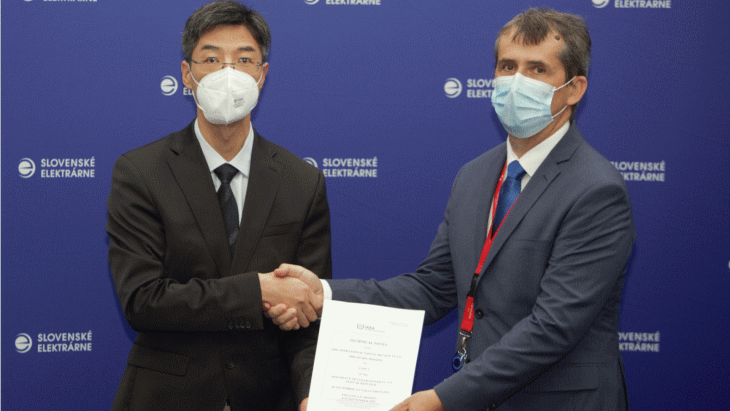IAEA sees improved operational safety at Mochovce 3
Slovenské Elektrárne has strengthened operational safety at unit 3 of Slovakia's Mochovce nuclear power plant ahead of commercial operation, an expert team from the International Atomic Energy Agency (IAEA) has concluded. The team said the plant management had made significant progress in addressing the findings of a previous IAEA review in 2019.

Pre-OSART mission leader Fuming Jiang with Martin Mráz, station director of the Mochovce plant (Image: Slovenské Elektrárne)
Pre-Operational Safety Review Team (Pre-OSART) missions aim to improve operational safety by objectively assessing safety performance using the IAEA's Safety Standards and proposing recommendations for improvement where appropriate. The review covered the areas of leadership and management for safety; training and qualification; operations; maintenance; technical support; operating experience; radiation protection; chemistry; emergency preparedness and response; accident management; human, technology and organisational interactions; and commissioning.
A Pre-OSART mission to Mochovce in late-November 2019 concluded Slovenské Elektrárne had shown a commitment to safety, but also identified areas for further enhancements.
The five-day follow-up mission to Mochovce, which concluded on 10 September, was conducted at the request of the Nuclear Regulatory Authority of the Slovak Republic (UJD SR) to evaluate progress made in addressing the findings of the Pre-OSART review two years ago. The five-member mission team comprised experts from Canada, Germany, and the UK and two IAEA officials. The team was led by Fuming Jiang, head of the IAEA's Operational Safety Section.
The mission team found that several findings from the 2019 review had been fully addressed by the plant, including: improving the unit 3 operator training, for example, by using an upgraded simulator and through strengthened formal evaluations; enhancing its practice in the labelling and safe use of chemical substances, for example, through additional training and regular checks; and improving the maintenance of its emergency response facilities and equipment.
The team noted that further efforts are required to fully implement some actions drawn up after the 2019 mission, including: the plant should continue to improve the promotion of high standards in staff behaviours and plant conditions to ensure personnel safety; it should continue to improve its maintenance work practices; and it should continue to enhance the coordination and internal communication for planning and execution of commissioning activities.
"The plant has implemented many actions to address the findings of the 2019 mission. We are pleased to observe significant improvements," Jiang said. "The team encourages the plant to complete the remaining planned actions to improve its safety performance further."
"Continuous improvement, openness and transparency were the reasons why we invited this mission. I am very pleased that the IAEA experts noted significant positive progress compared to the Pre-OSART mission in 2019," said Branislav Strýček, General Director of Slovenské Elektrárne. "Once again, we received very valuable feedback from them that will help us in our continuous improvement. We will implement all the suggestions and recommendations, and I am confident that, also thanks to them, we will achieve our ambitious safety performance targets."
The IAEA team provided a draft report of the mission to the plant management. The plant management and UJD SR, which is responsible for nuclear safety oversight in the country, will have the opportunity to make factual comments on the draft. The IAEA will review them and will submit the final report within three months.
Construction of the first two 471 MWe VVER units at the four-unit Mochovce plant started in 1982. Work began on units 3 and 4 in 1986, but stalled in 1992. The first two reactors were completed and came into operation in 1998 and 1999 with a project to complete units 3 and 4 beginning ten years later. The final design includes many upgrades to safety and security, including increased aircraft impact protection and emergency management measures based on lessons from the Fukushima accident which were incorporated during the project.
Mochovce 3 successfully completed hot testing in April 2019 and an operating licence for the unit was issued by the Slovak nuclear regulator in May. Slovenské Elektrárne is expected to load fuel and commission the unit later this year. Mochovce 4 should begin operation in 2023.
Researched and written by World Nuclear News
- China Institute of Atomic Energy
- Nuclear Power Institute of China
- Southwestern Institute of Physics
- China Nuclear Power Operation Technology Corporation, Ltd.
- China Nuclear Power Engineering Co., Ltd.
- China Institute for Radiation Protection
- Beijing Research Institute of Uranium Geology (BRIUG)
- China Institute of Nuclear Industry Strategy (CINIS)
- China Nuclear Mining Science and Technology Corporation


